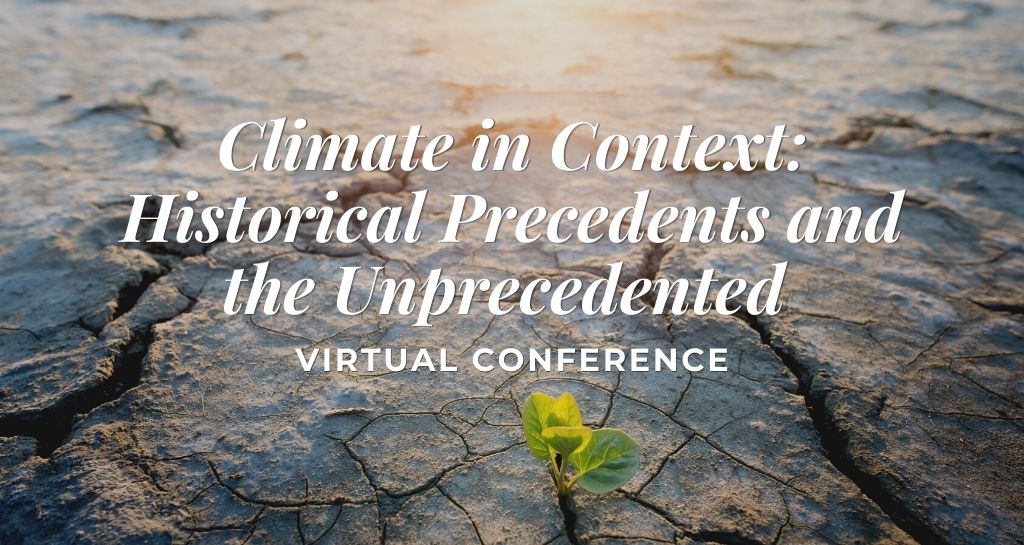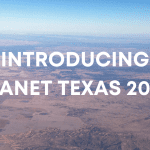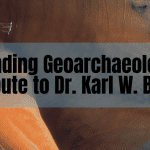
April 22-23, 2021
Institute for Historical Studies, University of Texas at Austin
As the culmination of a year-long series of events, this conference brought together diverse scholars whose work grapples with the challenges that climate change presents to the discipline of history. Participants addressed precedents for this “unprecedented” crisis by uncovering and analyzing the historical roots and analogues of contemporary climate change across a wide range of eras and areas around the world. Can history offer an alternative to visions of the future that appear to be determined by prevailing climate models, and help provide us with new ways of understanding human agency?
To consult specific conference sessions, use the links below:
THURSDAY, APRIL 22
Opening Remarks
Daina Ramey Berry
Chairperson of the History Department & Oliver H. Radkey Regents Professor of History
University of Texas at Austin
Miriam Bodian
Director of the Institute for Historical Studies & Professor of History
University of Texas at Austin
Land Acknowledgement
Luis Cárcamo-Huechante (Mapuche)
Director of Native American and Indigenous Studies
University of Texas at Austin
Conference Theme Introduction
Erika Bsumek
Associate Professor of History
University of Texas at Austin
Megan Raby
Associate Professor of History
University of Texas at Austin
Session I. Emerging Perspectives: A Graduate Student Roundtable
Mary E. Mendoza (Commentator), Pennsylvania State University
“An Upwelling of Stone: Climate Change and Infrastructure Agendas in Early Modern India”
Jonathan Seefeldt, University of Texas at Austin
Large-scale precolonial dams in South Asia have been persistently interpreted as prestige projects primarily concerned with royal legitimation. I am interested in thinking through the merits of this characterization and the histories it perhaps forecloses. To do so, I consider the case of Rajsamand in the semi-arid hills of the present-day western Indian state of Rajasthan. Built from 1662 to 1676 AD, Rajsamand remains one of the largest still-active precolonial embankment complexes in South Asia. The reservoir was the first major infrastructure project of Raj Singh I, a particularly enterprising regional monarch and a frequent thorn in the side of the Mughal empire. I consider what specific factors were projects such as Rajsamand—completed at tremendous expense with significant contributions from lower-level landholders—responding to other than a broadly-conceived, millennia-spanning, subcontinental-wide desire to project kingly power? To begin to answer this, I focus briefly on an unusual, understudied meteorological catalogue from the same period. This text, in alignment with the emerging consensus from proxy data, suggests the years surrounding Rajsamand’s construction were a time of failed monsoons, unusual aridity, and mounting social strain. I argue the vernacular texts on hand combine with the remarkable built footprint of Rajsamand and its sibling projects to present a picture of a precolonial state deeply involved in day-to-day efforts to stabilize the whims of the monsoon and sustain food production.
“Cultivating Parasitism: Early Modern Insect Crops and the Limits of Commodification”
Diana Heredia-López, University of Texas at Austin
This paper explores the implications of using the Plantationocene as a framework to explore the early environmental transformations in the Americas. It focuses on a seventeenth-century project to scale up the production of cochineal in the Yucatan peninsula. Cochineal, a red dyestuff endemic to southern Mexico, constituted one of the largest revenues for the Spanish empire. For more than three hundred years this dye’s production remained in the hands of indigenous households who knew how to maintain the parasitic relationship between the prickly pear cacti (Opuntia spp.) and the dye-bearing insect, Dactylopius coccus. The parasitic nature of cochineal cultivation contrasts with the inadvertent fostering of parasites and pests in modern day plantations. This paper thus highlights the need to investigate the different manifestations of parasitism throughout the Plantationocene as well as the non-linear trajectories of plantation agriculture.
“Technological Ambivalence: Skiers and the History of Climate Solutions”
Jesse Ritner, University of Texas at Austin
Ski resorts sell images of skiers in waist-deep snow. But the vision is a mirage. Most people ski on groomed beginner and intermediate runs. And most of these slopes are not covered with real snow. Rather, they are covered with artificial snow. This paper argues that the U.S. ski industry used snowmaking to adapt to variable climates that provide insufficient snow for modern ski resorts. The technology proved highly profitable. Yet, snowmaking, and the development that came from it, had both latent and manifest repercussions that influenced class and racial relations. The paper concludes by discussing how studying this highly specific climate adapting technology can help us think through the implementation and ramifications of new technologies that will likely be used as the planet continues to warm.
“Racial Capitalism and Climate Justice: Historical Perspectives on Environmental Racism in Texas”
Micaela Valadez, University of Texas at Austin
This short paper will briefly cover the history of Communities Organized for Public Service (COPS) in San Antonio, Texas, a mostly ethnic Mexican organization founded in 1974. I critique the historiography of the organization as unbalanced in the favor of COPS earliest victories without contending with the legacies of their work into the 2000s and their decision to not use the rhetoric of race or class when confronting people in power. Overall, I argue that if historians can be of any use to the current climate justice movement we have to divert our attention to understanding how communities of color fight against environmental and climate injustice. We have to consider the ways that the state responds to organizations like COPS that include giving in to their demands and allocating funds to prevent environmental disasters and hazards. Finally, we have to understand how these kinds of relationships between organizations and the state divert attention away from the systemic and structural sources of the very problems that COPS and groups like them were meant to confront.
“African Americans, Slavery, and the Long History of Environmental Degradation on the Gulf Coast”
Brooks Winfree, University of Texas at Austin
This think piece considers how the cotton-based plantation zone of the nineteenth-century Gulf South became a site of contestation over competing ideas of environmental use. White enslavers envisioned a vast and extremely profitable belt of cotton cultivation stretching from Alabama to eastern Texas, cultivated with the labor of enslaved African Americans on land appropriated from Native people. Even before their arrival in the region, enslaved people knew of the horrific laboring conditions of the “Cotton Kingdom,” where enslavers would compel them to labor long hours in one of the harshest physical environments in the continental United States. Yet the “Cotton Kingdom’s” economic success depended on enslaved people’s intimate familiarity with the land and their knowledge of agricultural techniques. Ultimately, the enslaved forged alternative understandings of the environment around them by incorporating the physical world in religious practices, interpreting the new landscape in ways that privileged African, rather than Euro-American, land uses, and using the features of the terrain to secure their freedom. This piece concludes by calling on scholars to more seriously consider slavery and enslaved people’s interest in forging alternative understandings of the land as key themes for environmental histories.
Opening Keynote Address: Bathsheba Demuth, Brown University
“The Reindeer and the End of the World: Apocalypse, Climate, and Soviet Dreams”
Session II. Historicizing Climate
Megan Raby (Chair), University of Texas at Austin
“Beyond Numbers: Knowing Typhoons in Late Imperial China”
Clark L. Alejandrino, Trinity College Hartford
Numbers dominate the study of past storms in particular, and to some extent historical climatology in general. We need to count the number of storms and we need to measure how strong they were on the Saffir-Simpson scale. Historical climatologists have subjected documentary evidence for storms, such as those from China, to the “tyranny of numbers” with some refusing to recognize records that have no barometric readings or wind speed measurements. I argue in this paper that we need to go beyond this fetish for numbers from modern meteorology and take seriously the very different ways that people along the South China coast recognized, understood, and conceived of typhoons in the past. One need not have measurable typhoons or a precise count of their number to write a history of typhoons.
“Degrees of Vulnerability: Why We Need a Feminist History of Climate Science”
Deborah Coen, Yale University
Knowledge for the Anthropocene is necessarily knowledge of our own vulnerability. But what kind of a scientific object is human vulnerability? Diverse concepts of human vulnerability to climate change have developed since the 1970s at a nexus between disciplines that might otherwise never have encountered each other: atmospheric science, critical geography, political ecology, development economics, human rights law, and feminist epistemology. While no consensus has been reached on the concept’s meaning, the efforts to define it have constituted a vital and necessary conversation about the role of values in scientific inquiry. Viewed historically, I hypothesize, this evolving discourse reveals the influence of the global feminist movement of the 1980s and ‘90s. Echoing Indigenous philosophers, feminist practitioners of “vulnerability science” have rejected the fetishization of the autonomy of the scientific researcher, insisting instead that relationships of interdependence are foundational to knowledge-making. They have posited the performative character of knowledge of human-environment interactions and the co-production of science and communities of scientific knowers. Yet the scientific institutions they work within exert constant pressure to deny these relations of interdependence. Taking a deeper historical view, we can recognize this resistance as a historical legacy of the Kantian fiction of the autonomy of the moral and epistemic subject. A history of the science of climate vulnerability should attend to the presence of this past, the living legacy of two centuries of efforts to separate the knowing human subject from the human object of geophysical influence. For our vulnerability to climate is co-extensive with our capacity to know climate, by exposing ourselves to new experiences of the atmosphere and new relations of interdependence with other beings.
“The Anthropocene and Epistemological Colonialism: The 18th-Century Spanish American Origins of Humboldt’s Global Histories of the Earth and Climate Change”
Jorge Cañizares-Esguerra, University of Texas at Austin
“Measuring Climate by Proxy”
Melissa Charenko, Michigan State University & IHS Fellow
Climate proxies are the preserved physical characteristic of past climates that stand in for direct meteorological measurements. These natural recorders of climatic variability are ubiquitous in studies of climate since they are some of the only ways to determine climatic conditions over the vast stretches of Earth’s history where no instrumental measurements or record-keeping exist. This paper examines how scientists’ use of proxies constrained and compelled what they thought about climate’s past and future. It focuses on predictions possible from tree rings in the 1920s as well as pollen analysis’ limited ability to predict in the 1980s given the “unprecedented” future that awaited because of global warming.
FRIDAY, APRIL 23
Opening Remarks
David Mohrig
Associate Dean for Research, Jackson School of Geosciences
University of Texas of Austin
Session III. Contextualizing the Climate Crisis
Tracie Matysik (Chair), University of Texas at Austin
“Skin and Fuel: Some Episodes from the Fossilization of Whiteness”
Andreas Malm, Lund University
What does the rise of the far right mean for the battle against climate change? In the first study of the far right’s role in the climate crisis, White Skin, Black Fuel: On the Danger of Fossil Fascism, authored by Dr. Malm and the Zetkin Collective (Verso Books, May 2021), presents an eye-opening sweep of a novel political constellation, revealing its deep historical roots. Fossil-fueled technologies were born steeped in racism. No one loved them more passionately than the classical fascists. Now right-wing forces have risen to the surface, some professing to have the solution—closing borders to save the nation as the climate breaks down. Epic and riveting, White Skin, Black Fuel traces a future of political fronts that can only heat up. For this conference, Dr. Malm has made available for pre-circulation Chapter 9 of White Skin, Black Fuel, entitled “Skin and Fuel.”
“The Cene Scene: Modernization Myths, Navajo Coal Development, and the Making of Arizona”
Andrew Curley, University of Arizona
“States of Second Nature”
Victor Seow, Harvard University
“Gathering Clouds over Petropolis: A Prolegomena”
Christopher Sellers, Stony Brook University & IHS Fellow
Global climate change has spurred notions like the Anthropocene that have further thickened the Western academy’s grasp of worldwide environmental change, but often with limited regard for more local and human scales of historical action, where the climate crisis itself was born. I present here a prolegomena for a book that seeks to reckon with how multi-scalar as well as political the human making of the climate crisis has been. To do so, it carves out a narrower focus, tightening its lenses on the global and the local as well as more intermediate scales to better illuminate their connections, parallels, and interactions. I tease out a single historical thread within the anthropogenesis of climate change, of that one industry responsible for more greenhouse emissions than any other in human history: oil. To coherently render the local faces of this industry’s more over-arching history, my narrative centers on two locales: the eastern coast of Texas, around Houston, and the southern coast of Veracruz, in Mexico. Set in very similar landscapes along the Gulf of Mexico shoreline, both became centers for the global oil industry, one in the Global North and the other in the Global South. While ranging upward to state, regional, national, and transnational and global scales, I repeatedly return to these local places. Their transformations offer a concrete window on how corporations, governments, and other institutions created and sustained the material conduits that have slaked the world’s growing thirst for petroleum over the last century. And the tensions and conflicts emerging in or implicating these places, environmental and otherwise, illuminate the politics through which oil’s ascent in these two nations was enabled as well as challenged. Probing these challenges at the local as well as the regional, national, and global levels, I explore where historical precedents for an effective climate politics may lie.
Session IV. Practicing What We Preach: A Roundtable
Erika Bsumek (Chair), University of Texas at Austin
“We Use the Living Earth to Make Our Histories”
Andrea Gaynor, University of Western Australia
Academic historians, among many others, have failed to fully confront the climate and biodiversity crises, often engaging in disavowal of the problems and our contribution to them in the course of our historical work. There are, however, several steps we can take to reconfigure our work for equity in a carbon-constrained world, many of which were outlined in a working paper on sustainable history drafted by a group of Australian historians in 2019. Building on the work of these authors and others, here I argue that historians have important roles to play in disrupting disavowal of the climate and biodiversity crises: by daily conducting our professional work as though we know the truth about planetary collapse, by acting to modify the institutional and wider social frameworks within which we operate, and by writing about the past as always a more-than-human unfolding.
“Rural Black Social Life in the Chesapeake After the 1933 Great Hurricane”
J. T. Roane, Arizona State University
“Louisiana: Race, Justice, and the Ecological Legacies of the Plantation Economy”
Justin Hosbey, Emory University
The humanitarian disaster triggered by Hurricane Katrina exposed the racial
violence and class domination that structures New Orleans and the broader U.S. South. In the immediate wake of the storm’s destruction of the U.S. Gulf Coast, the state of Louisiana transformed New Orleans’ public schools into privatized charter schools and commissioned the destruction of the majority of the city’s public housing. Drawing on ethnographic field research between 2013 and 2019, this article explores the social impact of this privatization by analyzing how the politics of space, place, and class in Black New Orleans have been transformed by post-Katrina redevelopment policies. Using geographer Clyde Woods’ analysis of New Orleans as a plantation geography, I mobilize critical work in Black geographies, Black studies, and cultural anthropology to argue that these reconstruction projects can be read as anti-Black spatial tactics that continue to unmoor low income and working class Black New Orleanians from their communities into the present.
“Writing History into the IPCC’s Sixth Assessment Report”
Paul N. Edwards, Stanford University
“Isn’t all Environmental Humanities ‘Environmental Humanities in Practice’?”
Dolly Jørgensen, University of Stavanger
When I and Franklin Ginn (University of Bristol, UK) took over as co-editors of the journal Environmental Humanities in January 2020, we began having discussions about how to make the journal more inclusive of environmental humanities practices, including the many community, outreach, and pedagogy projects that our practitioners are involved in. As part of that effort, we recently launched a category of article called “Environmental Humanities in Practice” targeting scholarship and sharing of experiences about interventionist work. Yet there is a tension in this decision to make a separate category of scholarship about outreach: Isn’t all environmental humanities really “environmental humanities in practice”?
Session V. Going Public with Climate History: A Roundtable
Joan Neuberger (Chair), University of Texas at Austin
“Specific Constraints for a Universal Challenge: Navigating Resources and Space to Create a History of Climate Science Exhibition”
D. O. McCullough, American Philosophical Society
Communicating the history of climate science holds promise as a way to help build public consensus around the climate crisis that matches the scientific consensus. This paper explores the challenges and possibilities of using museum exhibits to communicate the history of climate science and offers several suggestions for doing so effectively. Curators of history of climate science exhibitions should draw their narratives from the objects available for display, treat their own institutions as artifacts to model critical reflection about past practices in meteorology and climate, and foreground museum space and audience in the design process. These approaches can help exhibit designers maximize the potential of their particular resources to help solve this universal problem.
“When Will It Be Over? Water, Flood, Toxics, and the Duration of Colonial Legacies in Philadelphia”
Bethany Wiggin, University of Pennsylvania
In the absence of a direct hit from a super storm like Hurricane Sandy, Philadelphians are more likely to ask of climate change, “When Will It Begin?” rather than the question this paper poses, “When Will It Be Over?” By asking “When Will It Be Over?” this paper foregrounds climate impacts as ongoing colonial relations and explores the coloniality of climate change through a series of inter-related public humanities projects developed in Philadelphia amidst flash floods, refinery explosions, and school children’s hopes and dreams for Philadelphia at 2100. In raising questions about climate change’s origins and progress, it considers historical responsibility and asks for repair, including forms of research and teaching appropriate for the climate changed. It explores how best, in the words of the organizers of this conference, “we” might “go public.” Asking “When Will It Be Over” reminds us that we are working in the wake of Atlantic slavery, and it suggests the need for publicly engaged, anti-racist historical work that spans critique and action.
“Indian Ocean Current”
Prasannan Parthasarathi, Boston College
“Indian Ocean Current: Six Artistic Narratives” was an exhibit at Boston College’s McMullen Museum of Art in the spring and fall of 2020. The exhibit integrated material on climate change, ocean science, and the crisis of fisheries with the perspectives of six contemporary artists. This combination reflected the curators’ commitment to inject climate change into diverse conversations. Inspired by this goal, the South African artist Penny Siopis, did two new works for the show, “Warm Waters” and “She Breathes Water.”
“Modeling Virtual Angkor: An Evolutionary Approach to a Single Urban Space”
Tom Chandler, Monash University & Adam Clulow, University of Texas at Austin
The Virtual Angkor project aims to recreate the sprawling Cambodian metropolis of Angkor at the height of the Khmer Empire’s power and influence around 1300. For approximately 500 years from the ninth to the fifteenth centuries, the Khmer empire dominated the politics and economy of Southeast Asia. Centered on modern day Cambodia, it extended its influence across a vast swath of territory, encompassing most of present-day Thailand and the southern provinces of Laos and Vietnam. At its peak, the city of Angkor, which had an estimated 750,000 inhabitants dispersed over an interconnected, hydraulic landscape, was “thelargest settlement complex of the preindustrial world.” In the decade since it commenced, the Virtual Angkor project has evolved organically to encompass new technologies and approaches in an effort to present a comprehensive reconstruction of the city and its inhabitants. In this talk we explore the long development of the project, which scaled up from a single elephant to over 20,000 agents moving through a fully realized city, the challenges involved in modelling the environment and the question of climate variability and the decline of Angkor.
Concluding Remarks
Erika Bsumek
Associate Professor of History
University of Texas at Austin
Megan Raby
Associate Professor of History
University of Texas at Austin
Closing Keynote Address: Naomi Oreskes, Harvard University
Convened by Dr. Erika M. Bsumek, Associate Professor of History and Dr. Megan Raby, Associate Professor of History. Presented by the Institute for Historical Studies at the University of Texas at Austin.
Generously co-sponsored by:
- Department of History
- Planet Texas 2050
- Center for European Studies
- Department of African and African Diaspora Studies
- Dolph Briscoe Center for American History
- Department of Geography and the Environment
- Humanities Institute through the Sterling Clark Holloway Centennial Lectureship
- History & Philosophy of Science Speaker Series
- Center for American Architecture and Design, School of Architecture
- Native American & Indigenous Studies
- Environmental Humanities @UT, courtesy of the English Department
- Jackson School of Geosciences
The views and opinions expressed in this article or video are those of the individual author(s) or presenter(s) and do not necessarily reflect the policy or views of the editors at Not Even Past, the UT Department of History, the University of Texas at Austin, or the UT System Board of Regents. Not Even Past is an online public history magazine rather than a peer-reviewed academic journal. While we make efforts to ensure that factual information in articles was obtained from reliable sources, Not Even Past is not responsible for any errors or omissions.



